Chicago School (architecture) on:
[Wikipedia]
[Google]
[Amazon]
 Chicago's architecture is famous throughout the world and one style is referred to as the Chicago School. Much of its early work is also known as Commercial Style. In the
Chicago's architecture is famous throughout the world and one style is referred to as the Chicago School. Much of its early work is also known as Commercial Style. In the
 While the term "Chicago School" is widely used to describe buildings constructed in the city during the 1880s and 1890s, this term has been disputed by scholars, in particular in reaction to Carl Condit's 1952 book ''The Chicago School of Architecture''. Historians such as H. Allen Brooks, Winston Weisman and Daniel Bluestone have pointed out that the phrase suggests a unified set of aesthetic or conceptual precepts, when, in fact, Chicago buildings of the era displayed a wide variety of styles and techniques. Contemporary publications used the phrase "Commercial Style" to describe the innovative tall buildings of the era, rather than proposing any sort of unified "school."
Some of the distinguishing features of the Chicago School are the use of steel-frame buildings with masonry cladding (usually terra cotta), allowing large plate-glass window areas and limiting the amount of exterior ornamentation. Sometimes elements of
While the term "Chicago School" is widely used to describe buildings constructed in the city during the 1880s and 1890s, this term has been disputed by scholars, in particular in reaction to Carl Condit's 1952 book ''The Chicago School of Architecture''. Historians such as H. Allen Brooks, Winston Weisman and Daniel Bluestone have pointed out that the phrase suggests a unified set of aesthetic or conceptual precepts, when, in fact, Chicago buildings of the era displayed a wide variety of styles and techniques. Contemporary publications used the phrase "Commercial Style" to describe the innovative tall buildings of the era, rather than proposing any sort of unified "school."
Some of the distinguishing features of the Chicago School are the use of steel-frame buildings with masonry cladding (usually terra cotta), allowing large plate-glass window areas and limiting the amount of exterior ornamentation. Sometimes elements of
 Leiter II Building, 1891
*
Leiter II Building, 1891
*

 Reliance Building, 1890-1895
*
Reliance Building, 1890-1895
*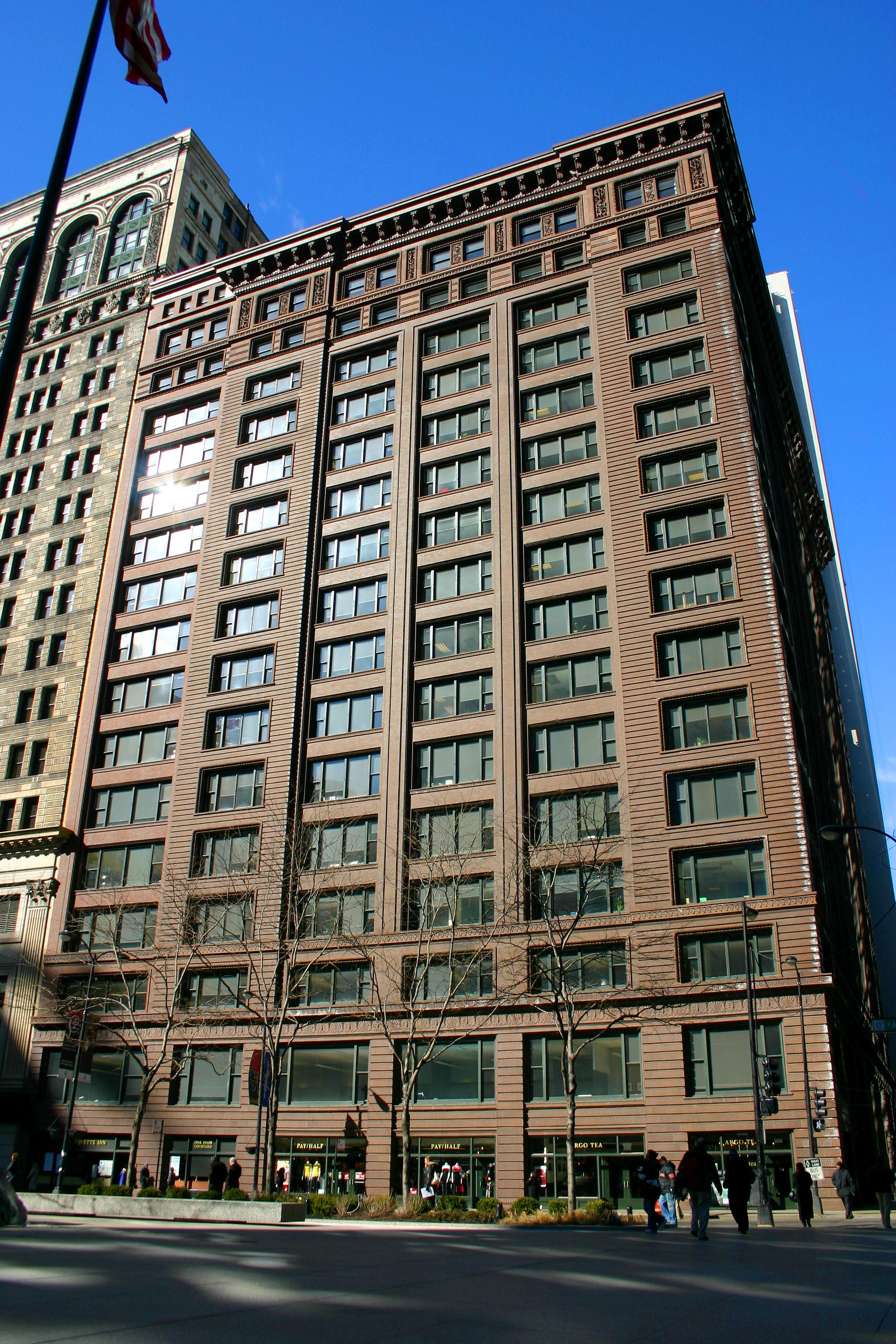 Marquette Building, 1895
*
Marquette Building, 1895
* Fisher Building, 1895-1896
*
Fisher Building, 1895-1896
* Gage Group Buildings, 1898
*
Gage Group Buildings, 1898
* Sullivan Center, 1899
*
Sullivan Center, 1899
*
 Chicago Building, 1904–1905
*
Chicago Building, 1904–1905
* Brooks Building, 1910
*
Brooks Building, 1910
* Transportation Building/Heisen Building, 1910-1911
Transportation Building/Heisen Building, 1910-1911
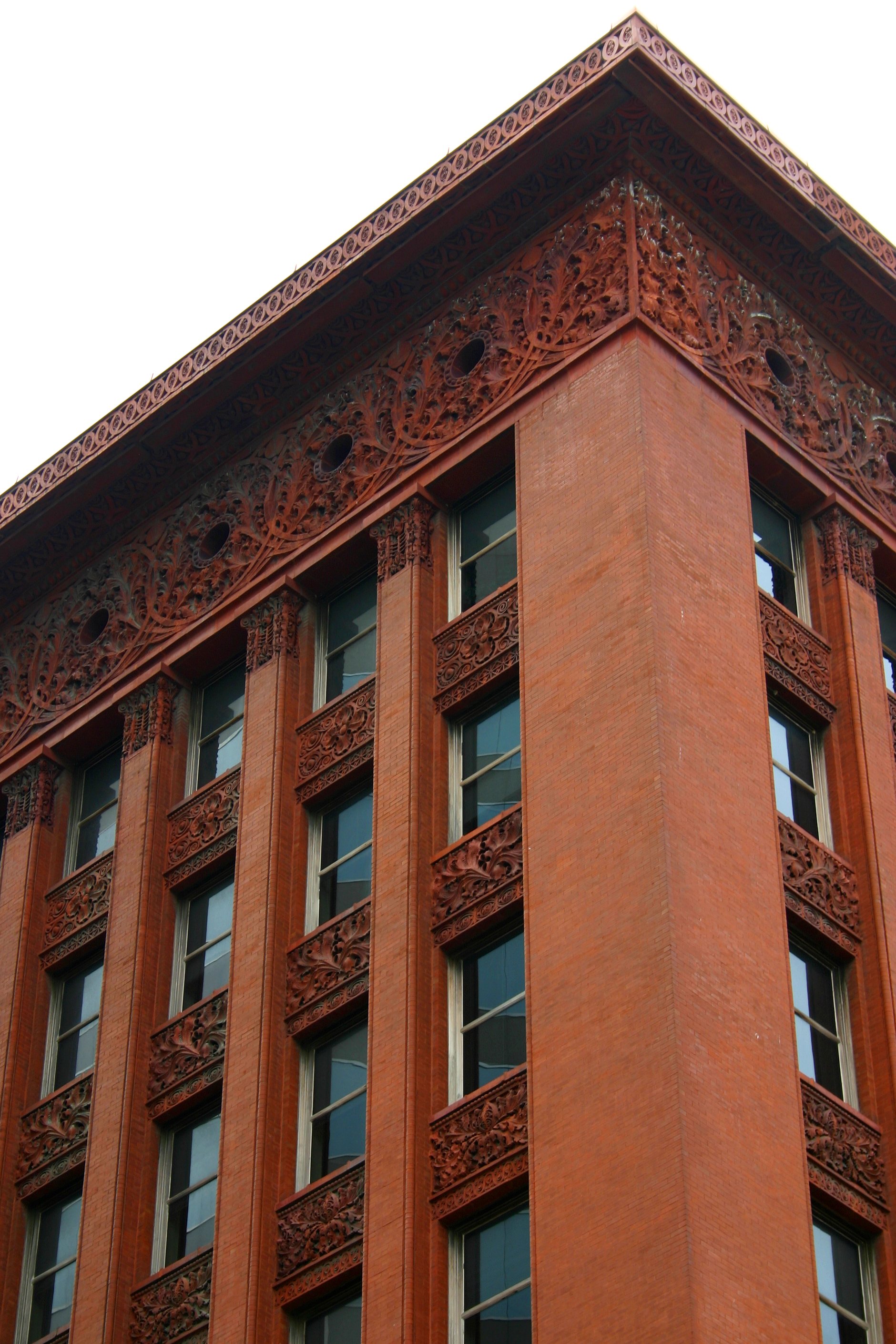

 Goodspeed Brothers Building, 1895, Grand Rapids, Michigan
*
Goodspeed Brothers Building, 1895, Grand Rapids, Michigan
*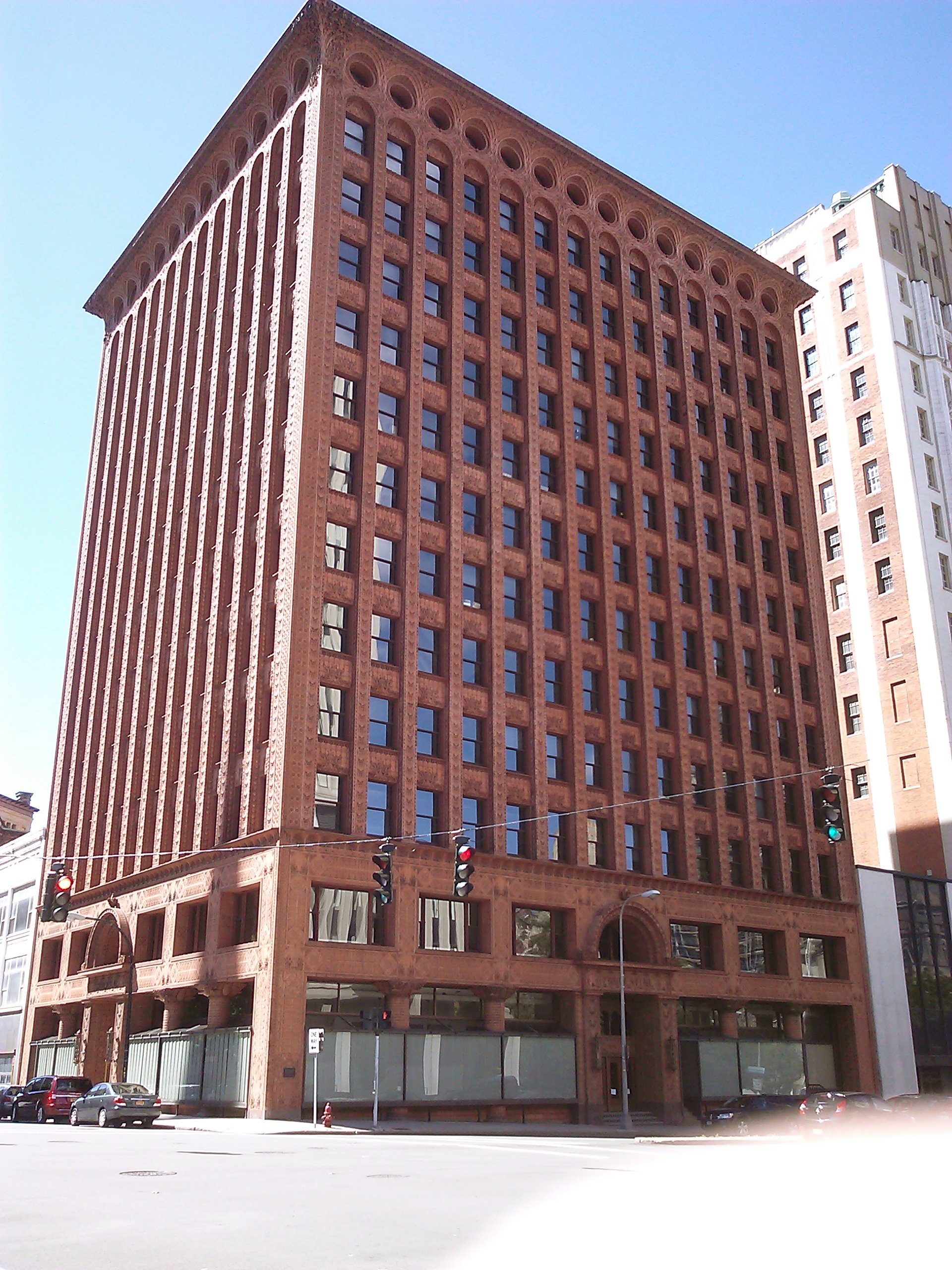
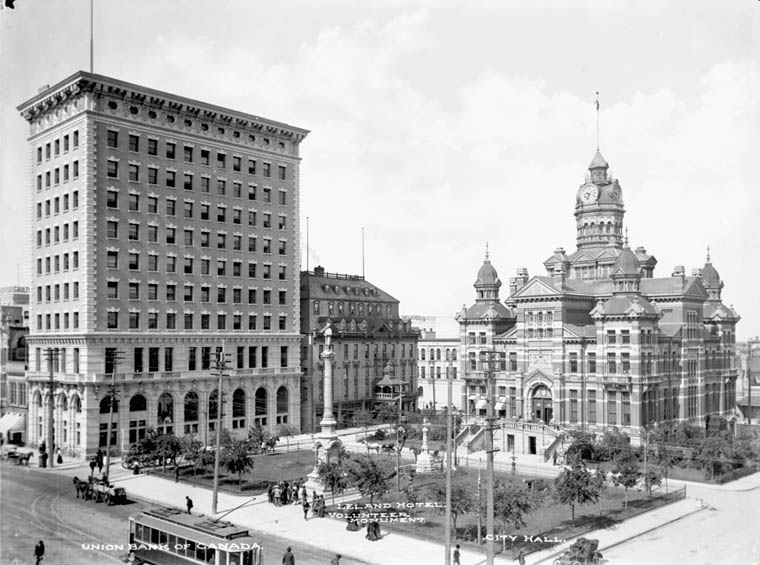

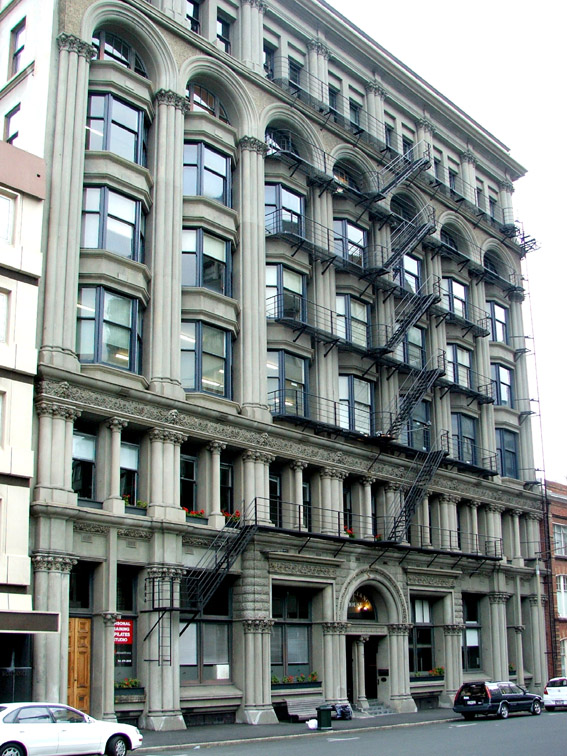
 Old National Bank Building, 1910, Spokane, Washington
*
Old National Bank Building, 1910, Spokane, Washington
* Swetland Building, 1910, Cleveland, Ohio
*
Swetland Building, 1910, Cleveland, Ohio
*
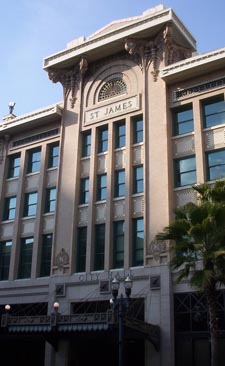 St. James Building, 1912, Jacksonville, Florida
*
St. James Building, 1912, Jacksonville, Florida
* Western Auto Building, 1914, Kansas City, Missouri
*
Western Auto Building, 1914, Kansas City, Missouri
* McLeod Building, 1915, Edmonton, Canada
*
McLeod Building, 1915, Edmonton, Canada
* LifeSavers Building, 1920, Port Chester, NY
*
LifeSavers Building, 1920, Port Chester, NY
*
 In the 1940s, a "Second Chicago School" emerged from the work of Ludwig Mies van der Rohe and his efforts of education at the Illinois Institute of Technology in Chicago. Mies sought to concentrate on neutral architectural forms instead of historicist ones, and the standard Miesian building is characterized by the presence of large glass panels and the use of steel for vertical and horizontal members.
The Second Chicago School's first and purest expression was the
In the 1940s, a "Second Chicago School" emerged from the work of Ludwig Mies van der Rohe and his efforts of education at the Illinois Institute of Technology in Chicago. Mies sought to concentrate on neutral architectural forms instead of historicist ones, and the standard Miesian building is characterized by the presence of large glass panels and the use of steel for vertical and horizontal members.
The Second Chicago School's first and purest expression was the
 Chicago's architecture is famous throughout the world and one style is referred to as the Chicago School. Much of its early work is also known as Commercial Style. In the
Chicago's architecture is famous throughout the world and one style is referred to as the Chicago School. Much of its early work is also known as Commercial Style. In the history of architecture
The history of architecture traces the changes in architecture through various traditions, regions, overarching stylistic trends, and dates. The beginnings of all these traditions is thought to be humans satisfying the very basic need of shelt ...
, the first Chicago School was a school
A school is an educational institution designed to provide learning spaces and learning environments for the teaching of students under the direction of teachers. Most countries have systems of formal education, which is sometimes co ...
of architect
An architect is a person who plans, designs and oversees the construction of buildings. To practice architecture means to provide services in connection with the design of buildings and the space within the site surrounding the buildings that h ...
s active in Chicago
(''City in a Garden''); I Will
, image_map =
, map_caption = Interactive Map of Chicago
, coordinates =
, coordinates_footnotes =
, subdivision_type = List of sovereign states, Count ...
in the late 19th, and at the turn of the 20th century. They were among the first to promote the new technologies of steel-frame construction in commercial buildings, and developed a spatial aesthetic which co-evolved with, and then came to influence, parallel developments in European Modernism
Modernism is both a philosophical and arts movement that arose from broad transformations in Western society during the late 19th and early 20th centuries. The movement reflected a desire for the creation of new forms of art, philosophy, an ...
. A "Second Chicago School" with a modernist aesthetic emerged in the 1940s through 1970s, which pioneered new building technologies and structural systems, such as the tube-frame structure.
First Chicago School
 While the term "Chicago School" is widely used to describe buildings constructed in the city during the 1880s and 1890s, this term has been disputed by scholars, in particular in reaction to Carl Condit's 1952 book ''The Chicago School of Architecture''. Historians such as H. Allen Brooks, Winston Weisman and Daniel Bluestone have pointed out that the phrase suggests a unified set of aesthetic or conceptual precepts, when, in fact, Chicago buildings of the era displayed a wide variety of styles and techniques. Contemporary publications used the phrase "Commercial Style" to describe the innovative tall buildings of the era, rather than proposing any sort of unified "school."
Some of the distinguishing features of the Chicago School are the use of steel-frame buildings with masonry cladding (usually terra cotta), allowing large plate-glass window areas and limiting the amount of exterior ornamentation. Sometimes elements of
While the term "Chicago School" is widely used to describe buildings constructed in the city during the 1880s and 1890s, this term has been disputed by scholars, in particular in reaction to Carl Condit's 1952 book ''The Chicago School of Architecture''. Historians such as H. Allen Brooks, Winston Weisman and Daniel Bluestone have pointed out that the phrase suggests a unified set of aesthetic or conceptual precepts, when, in fact, Chicago buildings of the era displayed a wide variety of styles and techniques. Contemporary publications used the phrase "Commercial Style" to describe the innovative tall buildings of the era, rather than proposing any sort of unified "school."
Some of the distinguishing features of the Chicago School are the use of steel-frame buildings with masonry cladding (usually terra cotta), allowing large plate-glass window areas and limiting the amount of exterior ornamentation. Sometimes elements of neoclassical architecture
Neoclassical architecture is an architectural style produced by the Neoclassical movement that began in the mid-18th century in Italy and France. It became one of the most prominent architectural styles in the Western world. The prevailing sty ...
are used in Chicago School skyscraper
A skyscraper is a tall continuously habitable building having multiple floors. Modern sources currently define skyscrapers as being at least or in height, though there is no universally accepted definition. Skyscrapers are very tall high-ri ...
s. Many Chicago School skyscrapers contain the three parts of a classical column. The lowest floors functions as the base, the middle stories, usually with little ornamental detail, act as the shaft of the column, and the last floor or two, often capped with a cornice and often with more ornamental detail, represent the capital.
The " Chicago window" originated in this school. It is a three-part window consisting of a large fixed center panel flanked by two smaller double-hung sash windows. The arrangement of windows on the facade typically creates a grid pattern, with some projecting out from the facade forming bay window
A bay window is a window space projecting outward from the main walls of a building and forming a bay in a room.
Types
Bay window is a generic term for all protruding window constructions, regardless of whether they are curved or angular, or ...
s. The Chicago window combined the functions of light-gathering and natural ventilation; a single central pane was usually fixed, while the two surrounding panes were operable. These windows were often deployed in bays, known as ''oriel window
An oriel window is a form of bay window which protrudes from the main wall of a building but does not reach to the ground. Supported by corbels, brackets, or similar cantilevers, an oriel window is most commonly found projecting from an upper f ...
s'', that projected out over the street.
Architects whose names are associated with the Chicago School include Henry Hobson Richardson, Dankmar Adler
Dankmar Adler (July 3, 1844 – April 16, 1900) was a German-born American architect and civil engineer. He is best known for his fifteen-year partnership with Louis Sullivan, during which they designed influential skyscrapers that boldly addr ...
, Daniel Burnham, William Holabird
William Holabird (September 11, 1854 in Amenia, New York – July 19, 1923 in Evanston, Illinois) was an American architect.
Holabird was the son of General Samuel B. Holabird and Mary Theodosia Grant. He studied at the United States Mil ...
, William LeBaron Jenney, Martin Roche
Martin Roche (1853–1927) was an American architect.
Life
In partnership with William Holabird, Martin Roche designed buildings following the Chicago School and that were landmarks in the development of early sky scrapers. He worked for Wi ...
, John Root
John Wellborn Root (January 10, 1850 – January 15, 1891) was an American architect who was based in Chicago with Daniel Burnham. He was one of the founders of the Chicago School style. Two of his buildings have been designated a National ...
, Solon S. Beman, and Louis Sullivan. Frank Lloyd Wright
Frank Lloyd Wright (June 8, 1867 – April 9, 1959) was an American architect, designer, writer, and educator. He designed more than 1,000 structures over a creative period of 70 years. Wright played a key role in the architectural movements o ...
started in the firm of Adler and Sullivan but created his own Prairie Style
Prairie School is a late 19th- and early 20th-century architectural style, most common in the Midwestern United States. The style is usually marked by horizontal lines, flat or hipped roofs with broad overhanging eaves, windows grouped ...
of architecture.
The Home Insurance Building
The Home Insurance Building was a skyscraper that stood in Chicago from 1885 to 1931. Originally ten stories and tall, it was designed by William Le Baron Jenney in 1884 and completed the next year. Two floors were added in 1891, bringing i ...
, which some regarded as the first skyscraper in the world, was built in Chicago in 1885
Events
January–March
* January 3– 4 – Sino-French War – Battle of Núi Bop: French troops under General Oscar de Négrier defeat a numerically superior Qing Chinese force, in northern Vietnam.
* January 4 &n ...
and was demolished in 1931.
Buildings in Chicago
* Leiter I Building, 1879 * Montauk Building, 1882–1883 * Rookery Building, 1886 * Auditorium Building, 1889 * Leiter II Building, 1891
*
Leiter II Building, 1891
*Ludington Building
The Ludington Building is the earliest-surviving, steel-frame building in Chicago, Illinois. It is located in the Chicago Loop community area. It was designed by William Le Baron Jenney and was named a Chicago Landmark on June 10, 1996. It was ...
, 1891-1892
*
Monadnock Building
The Monadnock Building (historically the Monadnock Block; pronounced ) is a 16-story skyscraper located at 53 West Jackson Boulevard in the south Loop area of Chicago. The north half of the building was designed by the firm of Burnham & Roo ...
, 1891–1893
* Reliance Building, 1890-1895
*
Reliance Building, 1890-1895
* Marquette Building, 1895
*
Marquette Building, 1895
* Fisher Building, 1895-1896
*
Fisher Building, 1895-1896
* Sullivan Center, 1899
*
Sullivan Center, 1899
*Heyworth Building
The Heyworth Building is a Chicago Landmark located at 29 East Madison Street, on the southwest corner of Madison Street and Wabash Avenue in Chicago, Illinois.
The building was constructed in 1904 by the architectural firm of D. H. Burnham & ...
, 1904
* Chicago Building, 1904–1905
*
Chicago Building, 1904–1905
* Brooks Building, 1910
*
Brooks Building, 1910
* Transportation Building/Heisen Building, 1910-1911
Transportation Building/Heisen Building, 1910-1911
Buildings outside Chicago
*
Wainwright Building
The Wainwright Building (also known as the Wainwright State Office Building) is a 10-story, terra cotta office building at 709 Chestnut Street in downtown St. Louis, Missouri. The Wainwright Building is considered to be one of the first aesthetic ...
, 1891, St. Louis, Missouri
*
Mills Building and Tower
The Mills Building and Tower is a two-building complex following the Chicago school with Romanesque design elements in the Financial District of San Francisco, California. The structures were declared San Francisco Designated Landmark #76, a ...
, 1892, San Francisco, California
* Goodspeed Brothers Building, 1895, Grand Rapids, Michigan
*
Goodspeed Brothers Building, 1895, Grand Rapids, Michigan
*
Prudential (Guaranty) Building
The Guaranty Building, formerly called the Prudential Building, is an early skyscraper in Buffalo, New York. It was designed by Louis Sullivan and Dankmar Adler and completed in 1896. The building has been declared a National Historic Landmark ...
, 1896, Buffalo, New York
*
Union Bank Building
The Union Bank Building ( the Union Bank Tower or Former Union Bank Building and Annex), located in the Exchange District of Winnipeg, Manitoba, is the first skyscraper in Canada, once forming the northern end of Main Street's prestigious Bank ...
, 1904, Winnipeg, Manitoba, Canada
*
Blount Building
The Blount Building is an historic seven-story Chicago school style office building located at 3 West Garden St., SW corner of Palafox St., Pensacola, Escambia County, Florida. It was built by Charles Hill Turner in 1906-1907 for local attorney ...
, 1907, Pensacola, Florida
*
Consultancy House
Consultancy House is a historic building in The Exchange, in downtown Dunedin, New Zealand. It has a New Zealand Historic Places Trust grade I classification.
Originally known as The New Zealand Express Company Building and also previously know ...
, 1910, Dunedin, New Zealand
* Old National Bank Building, 1910, Spokane, Washington
*
Old National Bank Building, 1910, Spokane, Washington
* Swetland Building, 1910, Cleveland, Ohio
*
Swetland Building, 1910, Cleveland, Ohio
*
Kearns Building
The Kearns Building is a historic office building in Salt Lake City, Utah, United States, that is listed on the National Register of Historic Places (NRHP).
Description
The 10-story building was designed by Los Angeles architects John Parkins ...
, 1911, Salt Lake City, Utah
* St. James Building, 1912, Jacksonville, Florida
*
St. James Building, 1912, Jacksonville, Florida
* Western Auto Building, 1914, Kansas City, Missouri
*
Western Auto Building, 1914, Kansas City, Missouri
* McLeod Building, 1915, Edmonton, Canada
*
McLeod Building, 1915, Edmonton, Canada
* LifeSavers Building, 1920, Port Chester, NY
*
LifeSavers Building, 1920, Port Chester, NY
*
Nicholas Building
The Nicholas Building is a landmark historic office and retail building located at 37 Swanston St, at the intersection of Swanston Street and Flinders Lane, in the Melbourne central business district, Victoria, Australia. Designed by architect H ...
, 1926, Melbourne, Australia
Second Chicago School
 In the 1940s, a "Second Chicago School" emerged from the work of Ludwig Mies van der Rohe and his efforts of education at the Illinois Institute of Technology in Chicago. Mies sought to concentrate on neutral architectural forms instead of historicist ones, and the standard Miesian building is characterized by the presence of large glass panels and the use of steel for vertical and horizontal members.
The Second Chicago School's first and purest expression was the
In the 1940s, a "Second Chicago School" emerged from the work of Ludwig Mies van der Rohe and his efforts of education at the Illinois Institute of Technology in Chicago. Mies sought to concentrate on neutral architectural forms instead of historicist ones, and the standard Miesian building is characterized by the presence of large glass panels and the use of steel for vertical and horizontal members.
The Second Chicago School's first and purest expression was the 860–880 Lake Shore Drive Apartments
860–880 Lake Shore Drive is a twin pair of glass-and-steel apartment towers on N. Lake Shore Drive along Lake Michigan in the Streeterville neighborhood of Chicago, Illinois. Construction began in 1949 and the project was completed in 1951 ...
(1951) and their technological achievements. The structural engineer for the Lake Shore Drive Apartments project was Georgia Louise Harris Brown
Georgia Louise Harris Brown (June 12, 1918 – September 21, 1999), is considered to be the second African American woman to become a licensed architect in the United States. She was also the first black woman to earn a degree in architecture from ...
, who was the first African-American to receive an architecture degree from the University of Kansas, and second African-American woman to receive an architecture license in the United States.
Skidmore, Owings & Merrill
Skidmore, Owings & Merrill (SOM) is an American architectural, urban planning and engineering firm. It was founded in 1936 by Louis Skidmore and Nathaniel A. Owings, Nathaniel Owings in Chicago, Illinois. In 1939, they were joined by engineer Jo ...
, a Chicago-based architectural firm, was the first to erect buildings conforming to the features of the Second Chicago School. Myron Goldsmith, Bruce Graham
Bruce John Graham (December 1, 1925 – March 6, 2010) was a Peruvian-American architect. Graham built buildings all over the world and was deeply involved with evolving the Burnham Plan of Chicago. Among his most notable buildings are the ...
, Walter Netsch
Walter A. Netsch (February 23, 1920 – June 15, 2008) was an American architect based in Chicago. He was most closely associated with the brutalist style of architecture as well as with the firm of Skidmore, Owings & Merrill. His signature aest ...
, and Fazlur Khan were among its most influential architects. The Bangladesh
Bangladesh (}, ), officially the People's Republic of Bangladesh, is a country in South Asia. It is the eighth-most populous country in the world, with a population exceeding 165 million people in an area of . Bangladesh is among the mo ...
i-born structural engineer Khan introduced a new structural system of framed tubes in skyscraper design and construction. The tube structure, formed by closely spaced interconnected exterior columns, resists "lateral forces in any direction by cantilevering from the foundation." About half the exterior surface is available for windows. Where larger openings like garage doors are required, the tube frame must be interrupted, with transfer girders used to maintain structural integrity. The first building to apply the tube-frame construction was the DeWitt-Chestnut Apartment Building
The Plaza on DeWitt was completed in 1966 as a residential apartment building at 260 E. Chestnut Street in the Streeterville neighborhood of Chicago. Originally called the DeWitt-Chestnut Apartment Building, and designed by Bangladeshi-Pakistani ...
, which Khan designed and was completed in Chicago
(''City in a Garden''); I Will
, image_map =
, map_caption = Interactive Map of Chicago
, coordinates =
, coordinates_footnotes =
, subdivision_type = List of sovereign states, Count ...
by 1963. This laid the foundations for the tube structures of many other later skyscrapers, including his own John Hancock Center
The John Hancock Center is a 100- story, 1,128-foot supertall skyscraper located in Chicago, Illinois. Located in the Magnificent Mile district, the building was officially renamed 875 North Michigan Avenue in 2018.
The skyscraper was designed ...
and Willis Tower
The Willis Tower (originally the Sears Tower) is a 108- story, skyscraper in the Loop community area of Chicago in Illinois, United States. Designed by architect Bruce Graham and engineer Fazlur Rahman Khan of Skidmore, Owings & Merrill (SOM ...
.
Today, there are different styles of architecture all throughout the city, such as the Chicago School, neo-classical, art deco
Art Deco, short for the French ''Arts Décoratifs'', and sometimes just called Deco, is a style of visual arts, architecture, and product design, that first appeared in France in the 1910s (just before World War I), and flourished in the Unit ...
, modern
Modern may refer to:
History
*Modern history
** Early Modern period
** Late Modern period
*** 18th century
*** 19th century
*** 20th century
** Contemporary history
* Moderns, a faction of Freemasonry that existed in the 18th century
Philosophy ...
, and postmodern
Postmodernism is an intellectual stance or Rhetorical modes, mode of discourseNuyen, A.T., 1992. The Role of Rhetorical Devices in Postmodernist Discourse. Philosophy & Rhetoric, pp.183–194. characterized by philosophical skepticism, skepticis ...
.
See also
* Architecture of Chicago *Chicago Landmarks
Chicago Landmark is a designation by the Mayor and the City Council of Chicago for historic sites in Chicago, Illinois, United States. Listed sites are selected after meeting a combination of criteria, including historical, economic, archit ...
*Early Commercial architecture
In the United States, the National Register of Historic Places classifies its listings by various types of architecture. Listed properties often are given one or more of 40 standard architectural style classifications that appear in the National ...
* Chicago Seven (architects)
*Palazzo style architecture
Palazzo style refers to an architectural style of the 19th and 20th centuries based upon the '' palazzi'' (palaces) built by wealthy families of the Italian Renaissance. The term refers to the general shape, proportion and a cluster of characteri ...
References
Further reading
* Condit, Carl W. ''The Chicago school of architecture: a history of commercial and public building in the Chicago area, 1875-1925''. University of Chicago Press, 1973. * Leslie, Thomas. ''Chicago Skyscrapers, 1871-1934''. University of Illinois Press, 2013. {{Authority control American architectural styles Architecture in Illinois Architecture in Chicago 19th century in Chicago